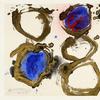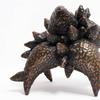A Recently Restituted Work By German Expressionist Ernst Ludwig Kirchner Is Acquired By Virginia Museum of Fine Arts
- RICHMOND, Virginia
- /
- January 21, 2021
The Virginia Museum of Fine Arts (VMFA) has announced that it has acquired a major work by German artist Ernst Ludwig Kirchner. The oil painting, completed in 1916, is entitled Taunus Road (German: Autostrasse im Taunus). In September 2020, a private collector in Germany made the fair and just decision to restitute Kirchner’s painting to the Fischer family descendants who have donated it to VMFA through a gift-purchase arrangement.
“We are pleased that this painting, Taunus Road, was returned to the Fischer family and that it joins other paintings by Kirchner in the Ludwig and Rosy Fischer Collection at the Virginia Museum of Fine Arts,” said Alex Nyerges, VMFA’s Director and CEO. “The donation of this painting is the realization of a long-term commitment on behalf of both the Fischer family and VMFA to reunite restituted works from the Fischer Collection.”
In 2016 Kirchner’s painting Sand Hills at Grünau was restituted by the Museum of Modern Art (MoMA) in New York to the descendants of Max Fischer as the result of a related Nazi era restitution case and acquired by VMFA through a similar gift-purchase arrangement. After this painting was returned to the family, they made clear their commitment to not only reunite it with the Ludwig and Rosy Fischer Collection at VMFA but also any future works from Max’s portion of the family collection that were restituted to the family.
“Having grown up in a home surrounded by these vivid works of art, it was a natural decision to send any restituted works to VMFA, to rejoin the Ludwig and Rosy Fischer Collection at the museum,” Eva Marx said. “By reuniting this work with the rest of the collection, we honor our grandparents’ vision and our parents’ dedication to sharing these works with the public.”
Ludwig and Rosy Fischer were forward thinking art collectors in Frankfurt, Germany, who between 1905 and 1925 built one of the most impressive collections of German Expressionist art of the time, with a special emphasis on the artists of the Die Brücke movement. Their sons, Ernst and Max, inherited the collection of approximately 500 works in 1926. After the Nazis gained power in Germany, Ernst left the country in 1934 and eventually settled in Richmond, Virginia, with his half of the collection. When Max left the following year, he was able to take only a few works out of Germany, and the remainder were presumed lost or stolen. Taunus Road is the second painting that has been recovered from the lost portion of Max’s half of the collection and returned to the Fischer descendants.
“Adding this work to the Ludwig and Rosy Fischer Collection helps us to tell a fuller story of the ways in which Hitler’s rise to power impacted the Fischer family and their collection. Displaying Taunus Road alongside Sand Hills in the German Expressionist Gallery adds significantly to our understanding of Ludwig and Rosy Fischers’ vision as important early collectors of Kirchner’s work in particular,” said Dr. Sarah Eckhardt, VMFA’s Associate Curator of Modern and Contemporary Art. “It is the enormous privilege of the museum to continue to work with the Fischer family as we steward this phenomenal collection of German art and share it with our public,” added Dr. Michael Taylor, VMFA’s Chief Curator and Deputy Director for Art and Education.
Kirchner was a leader and founding member of the Die Brücke group, formed in 1905. These artists looked at the rampant industrialization of the early 20th century with both fascination and despair. Responding to the changing world around them, they created art characterized by loose, gestural brushstrokes and vivid palettes of bold, saturated colors. While many of the Die Brücke artists depicted urban scenes, they also escaped their city studios to paint rural landscapes as antidotes to the pressures and anxieties of modern life. Landscapes were a central theme throughout Kirchner’s work.
Taunus Road provides a strong example of Kirchner’s vibrant landscapes produced between 1915 and 1918, a period scholars have described as Kirchner’s “crisis” years. He painted the scene in the midst of World War I, during his stay at the sanatorium in Königstein im Taunus, a community in the Taunus mountains north of Frankfurt where, after granted leave from the military, he received treatment following a nervous breakdown. Paint is applied in thin, loose layers to the canvas, producing a quickly executed, dynamic work. The curving trees on the left side and three purple clouds at the top of the composition frame the coral-colored highway. The division created by the roadway produces a tension between the idea of unadulterated nature and the incursion of humans into the landscape.
Taunus Road is currently on view in the German Expressionist Gallery at VMFA. Visit www.VMFA.museum for more information about the Ludwig and Rosy Fischer Collection and the museum’s provenance research practices.






10100x100_c.jpg)




![Peter Paul Rubens (Flemish, 1577–1640), After Titian (Tiziano Vecelli) (Italian [Venetian], c. 1488–1576), Rape of Europa, 1628–29. Oil on canvas, 71 7/8 x 79 3/8 in. Peter Paul Rubens (Flemish, 1577–1640), After Titian (Tiziano Vecelli) (Italian [Venetian], c. 1488–1576), Rape of Europa, 1628–29. Oil on canvas, 71 7/8 x 79 3/8 in.](/images/c/e2/2e/Jan20_Rape_of_Europa100x100_c.jpg)




